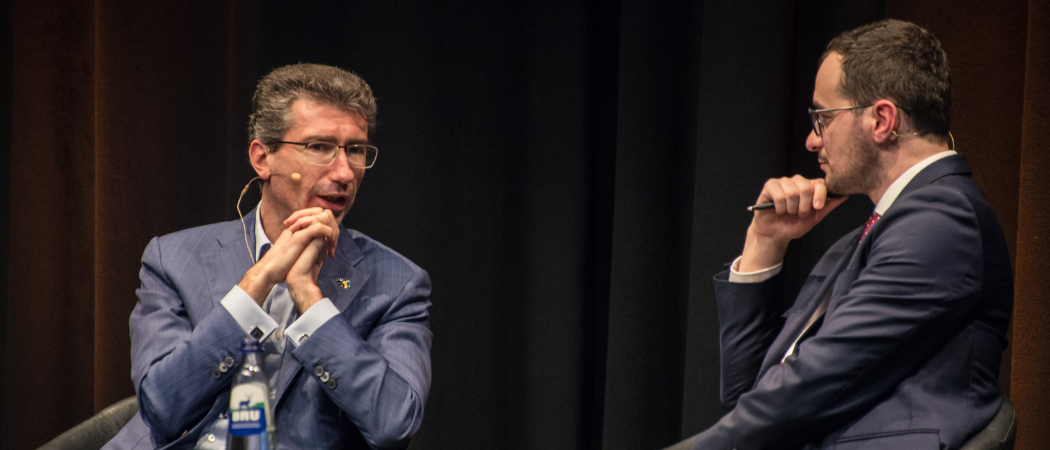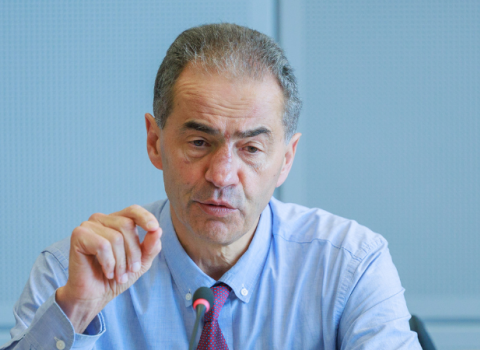EU’s basic research funder “is not living in a vacuum” and should listen to “evolving demands from society,” says Marc Lemaître

Marc Lemaître, director general for research and innovation (left) and Florin Zubașcu, executive editor at Science|Business (right). Photo credits: Jeroen Vanhecke
EU policymakers and research funders should be “obsessed” with economic impact as part of the Commission’s new competitiveness agenda, Marc Lemaître, director general for research and innovation, told the annual Science|Business conference on Thursday.
While the purpose of research and innovation goes beyond competitiveness, “we should wake up to the fact that this is what we will be judged upon ultimately in the coming years,” Lemaître said.
Last week the Commission presented its Competitiveness Compass, which will guide its work in the coming years and lays the groundwork for a greater focus on strategic technologies.
That document prompted concerns within the research community that the autonomy of the European Research Council (ERC) would be undermined, as it called for it to operate “along the same strategic interests” as the European Innovation Council (EIC).
“The ERC is not living in a vacuum,” said Lemaître. “It has an essential role to play for society, and I have no doubt that it is listening to the evolving demands from society, and today, yes, competitiveness is very high on that list.”
ERC’s core mission is to foster scientific excellence. Unlike other parts of the Framework Programme, it is managed by an independent scientific council, which has strongly resisted attempts to impose more top-down decision making.
This led to the dramatic resignation of former president Mauro Ferrari, in 2020, after he tried and failed to convince the council to establish a special initiative focused on COVID-19, to run in parallel to the ERC’s regular bottom-up research grants.
Lemaître pointed out that the organisation already supports the transition from research results to innovation, through its Proof of Concept grants, and suggested it could also play a greater role in attracting talent.
“[ERC] can perhaps also design some grants which would be more tailored for people who could be reflecting in the coming year or two, especially on the other side of the Atlantic, on their options.
“I think these are all valid points, which, in all respect for the ERC’s independence and its choices, can and should be brought to their attention.”
While the Competitiveness Compass plans to set top-down priorities in key sectors to steer funding, Lemaître said his personal view is that disruptive innovation also needs to be supported across sectors.
“We should not limit the scope of where disruptive innovation should come from, and this is why it should be, at least to a certain extent, free from top-down priorities. And this clearly starts in frontier basic research,” he said, noting that ERC is “a very compelling model for that”.
Mark Lloyd Davies, who oversees public-private partnerships at pharmaceutical firm Johnson & Johnson, agreed that industry and academia should be trusted to come forward with innovative ideas. “Once the civil service, if you like, has an idea to put forward […] it’s not necessarily the latest idea,” he said.
This is one of the benefits of the US Advanced Research Projects Agencies (ARPA) model the Commission wants to implement as part of the EIC, Davies said. ARPAs embrace risk and test out new ideas. “The beauty of it is, it helps organisations to fail fast, because most of the products don’t succeed, and that’s innovation.”
Framework Programme 10
There are also concerns that the successor to Horizon Europe, Framework Programme 10, will not be a standalone programme but integrated into a new Competitiveness Fund, after FP10 was not mentioned once in the Competitiveness Compass.
Lemaître was unable to confirm whether FP10 will have a “ringfenced” budget but acknowledged that there will be a “radical” reduction in the number of instruments in the next long-term EU budget in an effort to focus and simplify the various programmes.
The existence of an overall Framework Programme for research and innovation is however specified in the Treaty on the Functioning of the European Union. “The Commission will not ignore the treaty,” Lemaître said.
Earlier in the day, MEP Christian Ehler sought to reassure stakeholders, saying, “There will be a Framework Programme 10.”
Integrating research into the Competitiveness Fund is “really not an option, at least form the science point of view,” said Martina Brockmeier, president of the Leibniz Association, an alliance of German research institutes. She echoed concerns from universities that the Commission’s competitiveness plans focus on innovation, to the detriment of research.
“If you don’t have fundamental research, you don’t have innovation at some point, and that’s why we believe it should be a ringfenced budget,” she said, explaining that this would mean funds cannot be diverted to other areas.
The EU’s research chief refused to speculate about the budget for the next programme. However, in terms of providing more support for research and innovation, “we have about the best political backdrop we can dream of,” he said, after President Ursula von der Leyen vowed to increase research spending ahead of her re-election last year.
Research Commissioner Ekaterina Zaharieva has been trying to manage expectations, telling Science|Business that promising to double the Horizon Europe budget to at least €200 billion in FP10, as MEPs, lobbyists and expert advisors have called for, is “not realistic”.
Budget negotiations will be tough, with EU leaders also committed to ramping up defence spending, but Lemaître said the Competitiveness Compass, based around innovation, decarbonisation, and security, shows that all three are top priorities.
“It is not either we spend on research, or we spend on our defence capacities. We absolutely need to find a way to do both,” he said.
‘Research and Innovation Union’
In his influential report on EU competitiveness, Mario Draghi called for the creation of a Research and Innovation Union. This is needed if the EU is to finally make progress on the pledge to spend 3% of GDP on research and development, Lemaître said.
“We do set collective goals, but then we do not really have the collective monitoring mechanisms to see to it that progress is made,” he said. Since the goal was set in 2002, the EU average has only progressed from 1.8% to 2.2%. The upcoming European Research Area Act will be designed to work towards an R&I Union.
While public R&D spending is at a similar level in the EU and in the US, private investment is much higher on the other side of the Atlantic. However, public support will also be needed to leverage private funds.
“I don’t think we can count on the private sector being the one to fill the gap on its own,” Lemaître said, noting that public investment is currently at 0.7% of GDP, below the target of 1%.
The Draghi report also noted that only a tenth of public R&D spending in Europe happens at the EU level. In addition to better aligning national and EU priorities, Lemaître says there is an “extremely strong case” to be made for pooling a greater share of any additional public funds for research and innovation investments at European level.
“What is the marginal impact of one additional euro spent through the European level, as compared to one euro spent through national programmes? This is the question we should be asking ourselves, even before thinking of moving to 3%.”
While most of the debate currently is focused on FP10, due to begin in 2028, the Commission also sees opportunities to introduce more focus and simplicity in the medium term, particularly through its 2026-27 work programme.
“We are thinking about mobilising means for the new initiatives, very often sectorial initiatives, that we will see being putting on the table in the very next months,” said Lemaître.
Proposals such as a new clean industrial deal and a life sciences strategy could therefore be translated into the final years of Horizon Europe, and this would also mean concentrating means around a smaller number of topics in the collaborative research pillar, he added.
The Commission is also looking at reducing the number of so-called non-financial obligations included on application forms to make it easier to apply for funding.





 A unique international forum for public research organisations and companies to connect their external engagement with strategic interests around their R&D system.
A unique international forum for public research organisations and companies to connect their external engagement with strategic interests around their R&D system.